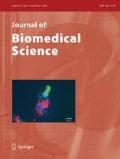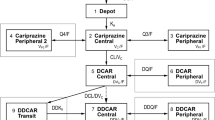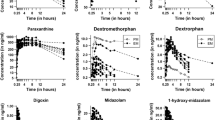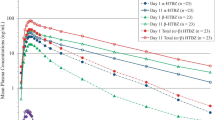Abstract
In this study, the metabolic ratios of dextromethorphan to dextrorphan (DM/DX) in plasma were calculated at steady state after administering 2 dosage forms (Medicon® and Detusiv®) of DM with different release rates. The urinary metabolic ratio for each subject was also determined based on the total drug concentration in the urine. An analysis of pharmacokinetic parameters for determining the DM metabolic phenotype was conducted. Results demonstrate that double logarithmic correlations between the metabolic ratios based on pharmacokinetic parameters of either AUC0-τ,ss, Cmax,ss, Cmin,ss, or Cave,ss for Medicon and Detusiv and the urinary metabolic ratios were all significant. Probit plots of the metabolic ratios based on these pharmacokinetic parameters revealed 2 clusters of distribution, representing extensive and intermediate metabolizers. An antimode of 2.0 for total drug based on these pharmacokinetic parameters was determined and correspondingly referred to an antimode of 0.02 for the urinary metabolic ratio to delineate extensive and intermediate metabolizers. This model was also verified to be appropriate when using total plasma concentrations of DM and DX at any time during the period of the dosing interval at steady state to calculate the metabolic ratio for identifying extensive and intermediate metabolizers. Therefore, the metabolic ratio based on the pharmacokinetic parameters of either AUC0-τ,ss, Cmax,ss, Cmin,ss, or Cave,ss and plasma concentrations of DM and DX in a single blood sample at steady state are proposed as an alternative way to identify phenotypes of CYP2D6.
Similar content being viewed by others
References
Ducharme J, Abdullah S, Wainer WI. Dextromethorphan as an in vivo probe for the simultaneous determination of CYP2D6 and CYP3A activity. J Chromatogr B Biomed Appl 678:113–128;1996.
Edeki T. Clinical importance of genetic polymorphism of drug oxidation. Mt Sinai J Med 63:291–300;1996.
Engel G, Hofmann U, Kroemer HK. Prediction of CYP2D6-mediated polymorphic drug metabolism (sparteine type) based on in vitro investigations. J Chromatogr B Biomed Appl 678:93–103;1996.
Führ U, Rost KL. Simple and reliable CYP1A2 phenotyping by the paraxanthine/caffeine ratio in plasma and in saliva. Pharmacogenetics 4:109–116;1994.
Goldstein JA, Faletto MB, Romkes-Sparks M. Evidence that CYP2C19 is the major (S)-mephenytoin 4′-hydroxylase in humans. Biochemistry 33:1743–1752;1994.
Gonzalez FJ, Skoda RC, Kimura S, et al. Characterization of the common genetic defect in humans deficient in debrisoquine metabolism. Nature 331:442–446;1988.
Henthorn TK, Benitez J, Avram MJ. Assessment of the debrisoquin and dextromethorphan phenotyping tests by gaussian mixture distributions analysis. Clin Pharmacol Ther 45:328–333;1989.
Horai Y, Nakano M, Ishizaki T, et al. Metoprolol and mephenytoin oxidation polymorphisms in Far Eastern Oriental subjects: Japanese versus mainland Chinese. Clin Pharmacol Ther 46:198–207;1989.
Hou ZY, Chen CP, Yang WC, Lai MD, Buchert ET, Chung HM, et al. Determination of dextromethorphan metabolic phenotype by salivary analysis with a reference to genotype in Chinese patients receiving renal hemodialysis. Clin Pharmacol Ther 59:411–417;1996.
Hou ZY, Pickle LW, Meyer RN, Woosley RL. Salivary analysis for determination of dextromethorphan metabolic phenotype. Clin Pharmacol Ther 49:410–419;1991.
Hu OY, Tang HS, Lane HY, Chang WO, Hun TM: Novel single-point plasma or saliva dextromethorphan method for determining CYP2D6 activity. J Pharmacol Exp Ther 285:955–960;1998.
Jacqz-Aigrain E, Funck Brentano C, Cresteil T. CYP2D6- and CYP3A-dependent metabolism of dextromethorphan in humans. Pharmacogenetics 3:197–204;1998.
Kerry NL, Somogyi AA, Bochner F, Mikus G. The role of CYP2D6 in primary and secondary oxidative metabolism of dextromethorphan: In vitro studies using human liver microsomes. Br J Clin Pharmacol 38:243–248;1994.
Kevorkian JP, Michel C, Hofmann U, et al. Assessment of individual CYP2D6 activity in extensive metabolizers with renal failure: Comparison of sparteine and dextromethorphan. Clin Pharmacol Ther 56:583–592;1996.
Kivisto KT, Kroemer HH. Use of probe drugs as predictors of drug metabolism in humans. J Clin Pharmacol 37:40–48S;1997.
Köhler D, Härtter S, Fuchs K, Sieghart W, Hiemke C. CYP2D6 genotype and phenotyping by determination of dextromethorphan and metabolites in serum of healthy controls and of patients under psychotropic medication. Pharmacogenetics 7:453–461;1997.
Larrey D, Babany G, Tinel M, et al: Effect of liver disease on dextromethorphan oxidation capacity and phenotype: A study in 107 patients. Br J Clin Pharmacol 28:297–304;1989.
Meyer UA. Molecular mechanisms of genetic polymorphisms of drug metabolism. Annu Rev Pharmacol Toxicol 37:269–296;1997.
von Moltke LL, Greenblatt DJ, Grassi JM, Granda BW, Venkatakrishnan K, Schmider J, Harmatz JS, Shader R: Multiple human cytochromes contribute to biotransformation of dextromethorphan in vitro: Role of CYP2C9, CYP2C19, CYP2D6, and CYP3A. J Pharm Pharmacol 50:997–1004;1998.
Mortimer O, Lindström B, Laurell H, Bergman U, Rane A. Dextromethorphan: Polymorphic serum pattern of theO-demethylated and didemethylated metabolites in man. Br J Clin Pharmacol 27:223–227;1989.
Rodrigues AD. Measurement of human liver microsomal cytochrome P450 2D6 activity using [O-methyl-14C]dextromethorphan as substrate. Methods Enzymol 272:186–195;1996.
Rostami-Hodjegan A, Kroemer HK, Tucker GT. In vivo indices of enzyme activity: The effect of renal impairment on the assessment of CYP2D6 activity. Pharmacogenetics 9:277–286;1999.
Rostami-Hodjegan A, Nurminen S, Jackson PR, Tucker GT. Caffeine urinary metabolite ratios as markers of enzyme activity: A theoretical assessment. Pharmacogenetics 6:121–149;1996.
Schmid B, Bircher J, Preisig R, Kupfer A. Polymorphic dextromethorphan metabolism: Cosegregation of oxidativeO-demethylation with debrisoquin hydroxylation. Clin Pharmacol Ther 38:618–624;1985.
Straka RJ, Hansen SR, Walker PF. Comparison of the prevalence of the poor metabolizer phenotype for CYP2D6 between 203 Hmong subjects residing in Minnesota. Clin Pharmacol Ther 58:29–34;1995.
Author information
Authors and Affiliations
Rights and permissions
About this article
Cite this article
Yeh, GC., Tao, PL., Ho, HO. et al. Analysis of pharmacokinetic parameters for assessment of dextromethorphan metabolic phenotypes. J Biomed Sci 10, 552–564 (2003). https://doi.org/10.1007/BF02256117
Received:
Accepted:
Issue Date:
DOI: https://doi.org/10.1007/BF02256117




